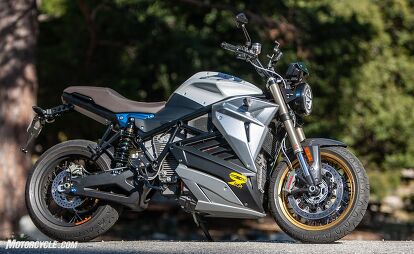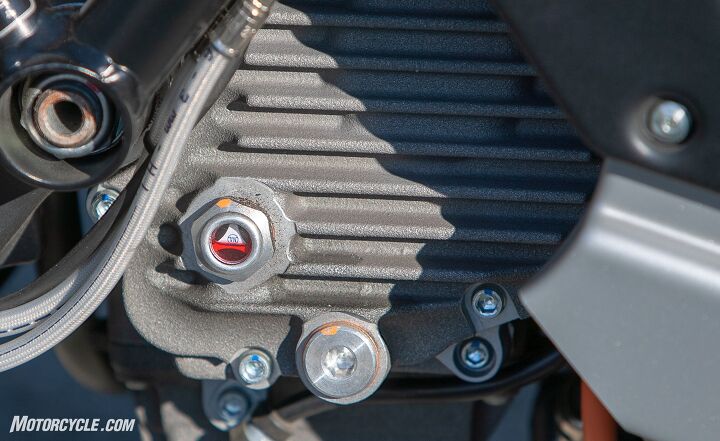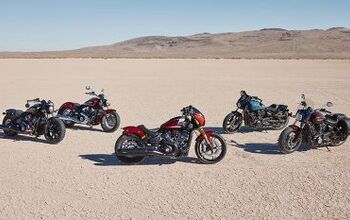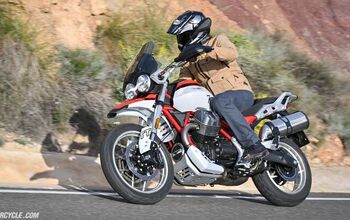2018 Energica Eva Esse Esse 9 Review

Energica's electric roadster delivers the goods
When you think of Italian motorcycles, you probably think of something sexily swoopy, a trellis frame, top-notch componentry, and a throaty V-Twin engine. The thought of an electric motor probably never enters your mind. However, Italian manufacturer Energica is doing its level best to change your thinking with its family of exotic electric motorcycles. From the Ego’s committed sportiness to the Eva’s street fighter stance (which was bolstered by having its motor output brought in line with that of the Ego for 2018), Energica’s motorcycles have always positioned themselves as premium electric performance motorcycles. When releasing the 2018 Energica Eva Esse Esse 9, the company created a premium electric roadster to round out its current model line.
2018 Energica Eva Esse Esse 9
| Engine | 18.5/20 |
| Suspension/Handling | 11.5/15 |
| Transmission/Clutch | 10/10 |
| Brakes | 8.5/10 |
| Instruments/Controls | 4.5/5 |
| Ergonomics/Comfort | 9.0/10 |
| Appearance/Quality | 9.0/10 |
| Desirability | 9.0/10 |
| Value | 7.5/10 |
| Overall Score | 87.5/100 |
2015 Energica Ego Second-Ride Review
2018 Energica Eva EsseEsse9 First Ride Review
Although this isn’t our first time riding the Esse Esse 9 (Kevin Duke had that honor back in February), Motorcycle.com is the first American publication to be given the opportunity to spend some time with the bike and put together a full review. We’ve had the bike for a couple of weeks and have been able to put it through its paces in a more thorough way than our previous short ride allowed. What we’ve learned is that the Esse Esse 9 is clearly cut from the same cloth as its siblings and, consequently, shares the same strengths and weaknesses.
Family heritage
While the appearance and the riding positions of the Energica family appear quite different, the trio are all based on the same platform. In true Italian style, the frame is a trellis high-strength steel unit. That frame connects to the massive battery box and electric motor housing, using them as a stressed member. Out back, a cast aluminum swingarm is controlled by a Bitubo shock that is adjustable for rebound and preload. Front suspension duties are handled via a fully-adjustable Marzocchi 43mm inverted fork. Where the Ego and the Eva receive cast aluminum wheels and more sporting rubber, the Esse Esse 9 wears a set of OZ Racing spoked wheels shod with tubeless Pirelli Phantom Sportscomp 120/70 ZR17 and 180/55 ZR17 front and rear.
Get the Flash Player to see this player.
All three Energicas have the same 11.7 kWh lithium-ion battery that is claimed to maintain up to 80% of capacity after 1200 charging cycles. What sets the trio apart from all other electric motorcycles currently available is its built-in charging system. Under the seat, an SAE J1772 plug allows the bike to be charged from 0-100% in 3.5 hours at any Level 2 charging station (a $2,295 option on a Zero). However, what really stands out when it comes to charging an Energica is its ability to be charged by a Level 3 DC Fast Charge – a method currently not offered on any other electric motorcycle. When hooked to a DC Fast Charger, an Energica will suck down electrons quick enough to reach an 85% charge from completely drained in a mere 20 minutes! While these chargers are less common than Level 2 chargers, more will appear as the electric vehicle infrastructure matures.
When it comes to converting that stored electricity to forward motion, the Esse Esse 9 differs from its siblings. Where the Ego and (new for 2018) Eva both have 107 kW motors that produce a claimed 145 hp and 148 lb-ft of torque, the Esse Esse gets an 80 kW motor for a claimed 109 hp and 133 lb-ft. We planned to visit the dyno during our loan, but Energica Italy wouldn’t allow it. So, we’ll have to rely on the carefully-calibrated MO Butt Dynos of myself and Road Test Editor, Troy Siahaan.
In action
By now, regular MO readers are familiar with the linear power delivery offered by electric motorcycles. Quite simply, unlike internal combustion engines (ICE), there is no building of power as the engine rpm increase. Rather, riders have the full measure of the motor’s output at their direct control. What is notable about the Esse Esse 9’s power delivery is how much finesse a rider can use in dialing in minute increments of acceleration.
Troy sums it up thusly: ”Speaking of power delivery, one of the most impressive things about the SS9 is that you can dial in just the amount of throttle input you desire. If you ask for two degrees more, that’s what you get. If you back out two degrees, you can feel that, too. It’s remarkable, and underappreciated until you ride a motorcycle with less refined power application.”
Additionally, unlike with some ICE motorcycles, there is a very distinct portion of the grip movement that allows the rider to maintain neutral throttle – keeping a constant speed. On bikes with poorly tuned EFI, riders often only have acceleration or deceleration to choose from, but in street riding, this middle ground makes it possible to optimize chassis stability in a corner or series of corners.
The Esse Esse 9 has the smaller of the two motor configurations offered by Energica, yet I never felt hampered by the fact. Troy agrees, describing the bike as “blindingly fast.” Naturally, on a track in the aggressive riding position of the Ego, we’d love to twist the throttle to the stop, but on the street, with the 9’s bolt upright riding position, we never felt like anything was lacking when we decided to pull its tail.
When it comes to the slowing properties of regenerative braking, the Energica has four levels: off, low, medium, and high. Depending on the type of road I was riding on, I tended to switch between low and medium regeneration. For example, when riding uphill in the mountains with gravity working in my favor when slowing down for a corner, low was sufficient to help me adjust my corner speed. While riding downhill or in tighter, twistier sections of road, medium was my setting of choice.
”Having four regen settings is cool,” opines Troy. ”I preferred the Low setting. The High setting wasn’t linear, and far too intrusive for my taste. In High, initially letting off the throttle would slow the bike down a degree, then once the bike slowed to a certain speed, it felt as if someone stomped on the rear brake and slowed you down some more. This made it hard to set up for a turn when you think you’ve set your corner speed, then the second burst of regen slows you even more.
About the weight
While the motor’s output did a good job of masking the Esse Esse 9’s 621-pound curb weight, the bike’s heft was clearly noticeable in both the braking and handling departments.
Like all Energicas, the Esse Esse 9 has a pair of 330mm discs squeezed by radial-mounted, four-piston Brembo M432 calipers. Although Troy and I chose different kinds of roads for our performance testing (I hit the swoopy Angeles Crest Highway and Troy rode in a tighter, twistier, point-and-shoot environment), we came to similar conclusions. First, the big discs and premium calipers were a must because of the mass that needed to be slowed. Second, the Esse Esse 9 tended to stand up under trail braking and preferred that corner speed be set early so that the throttle could be applied.
”The twin 330mm discs and Brembo calipers work especially hard to slow the motorcycle. Now I know that 621lbs is what it takes to make 330mm discs and Brembo calipers feel average in stopping power. What I found weird was that the SS9 feels like its weight is slightly biased towards the rear, so I was quite heavy on both front and rear brakes trying to slow her down.” Notes Troy, ”Since the bike tends to stand up when trail braking, I would drag the rear brake through a turn if I really had to shed some speed.”
In most situations, the suspension was able to handle the bike’s weight. On single bumps – or even stutter bumps – the suspenders did a good job of keeping the chassis from becoming unsettled. However, hit a G-out compression-type bump at speed, and the Bitubo shock’s rebound circuit simply wasn’t able to handle the recoil from a fully compressed rear suspension. This was even with the rebound set to full slow. The Marzocchi 43mm inverted fork was better able to handle this kind of bump, which we attribute to the rearward weight bias of the bike.
And the range?
We’ve mentioned sport riding quite a bit in this review, and that makes sense for a bike that is marketed as a premium electric performance motorcycle. With electrics, however, it always comes down to range, and speed drains batteries. So, as with every electric motorcycle I test, I subjected it to a completely unfair ride from my house up the Angeles Crest Highway to Newcomb’s Ranch and back. Usually, I turn around when the battery of my test bike gets to 40% because I know that I can make it to the Level 2 charging station at the base of the mountain.
However, this trip, I was having so much fun on the Esse Esse 9 that I blew past my self-imposed limit and rode all the way to Newcomb’s. Fortunately, they were willing to let me plug in to the wall outlet and charge the bike for the hour or so that I was eating and hanging around. By the time I was ready to leave, the charge had gone from 26% to 38%. So, I bombed down the mountain, comfortable in the knowledge that I’d make it to the charger. And I did. Only the charger was out of order. No worries, I still had 10% battery remaining, so I went to the next closest station. And it was broken, too. Sheesh. Now, I was on 9% with a predicted 13 miles of range. I was 15 miles from home.
At this point, I decided to attempt to make it all the way home by avoiding the battery-draining freeway and sticking to surface streets. Long, slooooow story short, I made it home with the last couple of miles in limp home mode, which limited my speed to an indicated 21mph. I arrived at my home Level 2 charging station with 0% battery indicated and dashes listed as my range. The final tally was 85.7 miles. Not bad for a Sunday morning’s sport ride on an electric motorcycle. For the rest of my rides, the Esse Esse 9 had plenty of range, though my longest daily ride was only 50 miles, which I think is typical of most riders.
(A quick note: Yes, the broken charging stations were a drag, but I’m not going to hold the state of the charging infrastructure against the motorcycle. You can decide if I’m being too forgiving, but I think not.)
Build quality
Since the Esse Esse 9 is a premium motorcycle, we have pretty high expectations for the fit-and-finish. For the most part, Energica has delivered. The front of the bike features a Marzocchi fork, Brembo brakes, and OZ Racing wheels. Where the two other Energica models have dual headlights, the Esse Esse 9’s round LED headlight looks the roadster part. The LED ring around the dual reflectors (for the high/low LEDs) stands out as the motorcycle approaches you on the road.
Behind the headlight, a TFT display does a nice job of relaying all the pertinent information to the rider. The tubular handlebar mounts to a CNC-machined triple clamp and riser, while the bar’s bend puts the rider in a perfectly upright riding position. The switchgear is easy to manipulate, and the ride/regen modes are adjustable on the fly. The shapely stepped seat is covered with dark brown leather. Below the seat is more machined aluminum, this time it’s anodized blue. Even the footpeg mounts are machined. Suffice as to say that the bike looks sweet!
The only fly in the premium ointment is the plastic-covered “tank.” For some reason, when the rider shifts around on the seat, the plastic panels rub against each other in a cheap-sounding creaky way. That’s really just a nit-pick, though.
As always, it’s about the ride
The Esse Esse 9’s riding position is quite upright, relaxed, and comfortable. The rider is in an ideal position for dealing with traffic in urban situations. When the cornering gets more aggressive, simply lean into the bar and use the width to lever the 9 into the turn. The Esse Esse 9, thanks to the bar, can be flicked onto its side, but it really prefers to be bent into corners. The same goes for the braking. While the Brembos offer the feel to trail brake into corners, the bike fights it a bit by standing up, leaving the rider with two choices: get the braking done (and hence get back on the throttle) early or drag the rear brake into the corner. Using one of these techniques, the Esse Esse 9 will gladly change lines mid-corner.
The acceleration, as noted above, is extremely tractable and exceedingly fun, requiring tons of self-control to keep out of throw-me-in-jail territory – just because of the addicting G-forces. When viewed at speed from the saddle, the Energica Esse Esse 9 achieves its goal of being a premium quality Italian roadster – in a class of one (or three if you include its Energica siblings). Is it worth its $24,940 MSRP? Only you can decide, but the reality is that the motorcycle is an exclusive item and out of reach for many riders (your humble MO staff, included). So, when looking at the bike logically, the Esse Esse 9 is an electric performance motorcycle for well-heeled riders. Although it requires the same compromises of every electric bike concerning range and charging infrastructure, its performance chops and DC Fast Charging capability set it apart from the rest of the electron-fueled pack. Riders who fit the Energica’s market segment who are looking for a roadster should find themselves quite happy with the Esse Esse 9.
2018 Energica Eva Esse Esse 9
+ Highs
- Acceleration!
- Precise throttle control
- DC Fast Charging
– Sighs
- Shock can get overwhelmed by bike’s heft
- We’ll always want more range
- Plastic-on-plastic rubbing on “tank” doesn’t reflect the premium build and price
In Gear

Helmet: HJC RPHA 90 Starting at $413.99
- Jacket: Alpinestars Viper Jacket Tech-Air Compatible $469.95
- Pants: Aerostich Protekt Jeans Starting at $117.00
- Gloves: Alpinestars GP Air $129.95
Boots: Alpinestars SP-1 V1 Riding Shoe No longer available
2018 Energica Eva Esseesse9 Specifications | |
|---|---|
| Colour | Lunar White – Shocking Blue – Metal Black |
| Motor | Permanent Magnet Ac, Oil Cooled |
| Horsepower | 109 hp (claimed) |
| Max Speed | Limited At 200 Km/H – 125 Mph |
| Torque | 79.7 lb-ft. |
| Riding Modes | 4 Riding Modes: Urban, Eco, Rain, Sport / 4 Regenerative Maps: Low, Medium, High, Off |
| Park Assistant | Back And Forth (2.8 Km/H – 1.74 Mph Max Speed) |
| Battery | Capacity 11.7 Kwh – Lithium Polymer – Life 1200 Cycles @ 80% Capacity (100% Dod) |
| Recharge | 30 Min (0-85% Soc) Fast Charge Dc Mode 4 / 3,5 H (0-100% Soc) Charge Mode 2 Or 3 |
| Battery Charger | Onboard, [110-220]V [50-60]Hz, 3 Kw. Conforms To Standards Sae J1772 And Iec 62196-2 With Pilot Signal For Charging Station Interface |
| Lpr Function | Long Period Rest: Allows The Maintenance And Automatic Balancing Of The Batteries During Long Period Of Non-Use |
| Dashboard | 4.3” Wqyga 480×272 TFT Colour Display With Internal Memory For Datalogging, Integrated Gps Receiver And Bluetooth Communication 16.7 Million Colours; 9 Warning Lights; 6 + 6 Current Consumption Lights; Ambient Light Sensor; Real Time Clock; Gps 10Hz. Possibility To View The Closest Charging Stations When Connected To Myenergica App. |
| Connectivity | Bluetooth Low Energy |
| Vehicle Control Unit | A Vehicle Control Unit Implementing A Multi-Map Adaptive Energy And Power Management Algorithm Manages The Vehicle. It Constantly Monitors Batteries, Even In Key Off Position |
| Front &Amp; Rear Wheel | Cast Aluminum: Front 3.5” X 17” / Rear 5.5” X 17” |
| Tyre | Pirelli Phantom – Front 120/70 Zr17 / Rear 180/55 Zr17 |
| Frame | Steel Tubular Trellis |
| Swingarm | Cast Aluminum |
| Front Suspension | Marzocchi Ø43 Mm, Adjustable Rebound And Compression Damping, Spring Preload |
| Rear Mono | Bitubo Rear Mono Shock Adjustable Rebound, Spring Preload |
| Chain | (16/44) 525 O-Ring Chain |
| Front Brake | Brembo, Double Floating Discs, Ø330 Mm, 4 Pistons Radial Caliper |
| Rear Brake | Brembo, Single Disc, Ø240 Mm, 2 Pistons Caliper |
| Abs | Bosch Switchable |
| Materials | Carbon Fiber/Abs |
| Dimensions | Seat Height 785 Mm/30,9”, Wheelbase 1494 Mm/58,8”, Length 2156 Mm/84,9”, Height 1250 Mm/49,2”, Width 901 Mm/35,5” |
| Warranty | 3 Years On Vehicle / 50.000 Km – 31.000 Miles On Battery |

Like most of the best happenings in his life, Evans stumbled into his motojournalism career. While on his way to a planned life in academia, he applied for a job at a motorcycle magazine, thinking he’d get the opportunity to write some freelance articles. Instead, he was offered a full-time job in which he discovered he could actually get paid to ride other people’s motorcycles – and he’s never looked back. Over the 25 years he’s been in the motorcycle industry, Evans has written two books, 101 Sportbike Performance Projects and How to Modify Your Metric Cruiser, and has ridden just about every production motorcycle manufactured. Evans has a deep love of motorcycles and believes they are a force for good in the world.
More by Evans Brasfield



































































Comments
Join the conversation
I'm thinking at least another decade for Ebikes to be anywhere near as practical and affordable as gas bikes and for the charging infrastructure to be handy everywhere.
What you are missing is maintenance cost. Driving 240-280 miles 6 days a week - Prior gas of $140- $180 per month vs. saving $80/ year on electric hourly billing. Also, no valve adjustments, nor oil changes every 3,000 miles. In 3 years you would save $6,000 plus the time to stop at a gas station or the motorcycle shop.